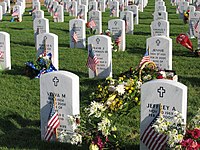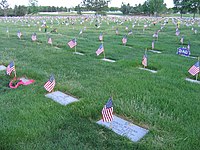United States National Cemetery System









The United States National Cemetery System is a system of 147 nationally important cemeteries in the United States. The authority to create military burial places came during the American Civil War, in an act passed by the U.S. Congress on July 17, 1862. By the end of 1862, 14 national cemeteries had been established (see text of photo). A national cemetery is generally a military cemetery containing the graves of U.S. military personnel, veterans and their spouses, but not exclusively so. The best known national cemetery is Arlington National Cemetery in Arlington County, Virginia, outside Washington, D.C.. Some national cemeteries, especially Arlington, contain the graves of important civilian leaders and other important national figures. Some national cemeteries also contain sections for Confederate soldiers. In addition to national cemeteries, there are also state veteran cemeteries.
The National Cemetery Administration of the United States Department of Veterans Affairs maintains 131 of the 147 national cemeteries as well as the Nationwide Gravesite Locator, which can be used to find burial locations of American military veterans.[1] The Department of the Army maintains two national cemeteries, Arlington National Cemetery and United States Soldiers' and Airmen's Home National Cemetery, and 39 other cemeteries across the United States under Army National Military Cemeteries. The National Park Service (NPS) maintains 14 cemeteries associated with historic sites and battlefields.
The American Battle Monuments Commission, an independent agency, maintains 26 American military cemeteries and other memorials outside the United States.
History
The first national cemeteries were set up after the United States Civil War by Edmund Burke Whitman.[2] Congress passed a law to establish and protect national cemeteries in 1867.[3]
Final military honors are provided for qualified veterans by several volunteer details known as a Memorial Honor Detail (MHD) upon request of family members through their choice of mortuaries handling the deceased's remains.
List of United States national cemeteries
See also
- Fort Leavenworth Military Prison Cemetery
- USVA emblems for headstones and markers
- List of military tombstone abbreviations
Notes and references
- ^ "Nationwide Gravesite Locator". National Cemetery Administration.
- ^ "Edmund Whitman (1812–1873)". University of Michigan. Retrieved 2008-10-31.
After the war Whitman became assistant quartermaster in charge of national cemeteries and mortuary records for the same district. Charged with inspecting cemeteries and battlefields, he located Union soldiers buried in Tennessee, Kentucky, Georgia, and Alabama.
- ^ Chap. LXI. 14 Stat. 399 from "A Century of Lawmaking for a New Nation: U. S. Congressional Documents and Debates, 1774–1875". Library of Congress, Law Library of Congress. Retrieved April 25, 2012.
- ^ Administration, National Cemetery. "Cape Canaveral National Cemetery - National Cemetery Administration". www.cem.va.gov. Retrieved 23 March 2018.
- ^ For information, see: NPS: Oakdale Cemetery Soldiers' Lot.
- ^ Most of the original burials were transferred to the Rock Island and Keokuk National Cemeteries.
Further reading
- Bontrager, Shannon. Death at the Edges of Empire: Fallen Soldiers, Cultural Memory, and the Making of an American Nation, 1863-1921 (University of Nebraska Press, 2020); memories of American war dead. online summary by author

